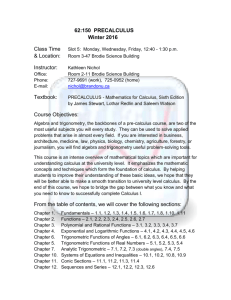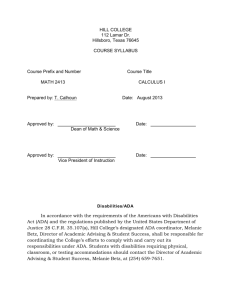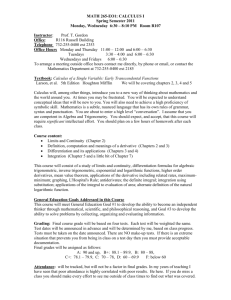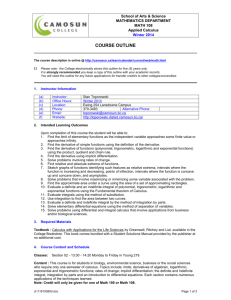AP Calculus AB - Madison Local Schools
advertisement
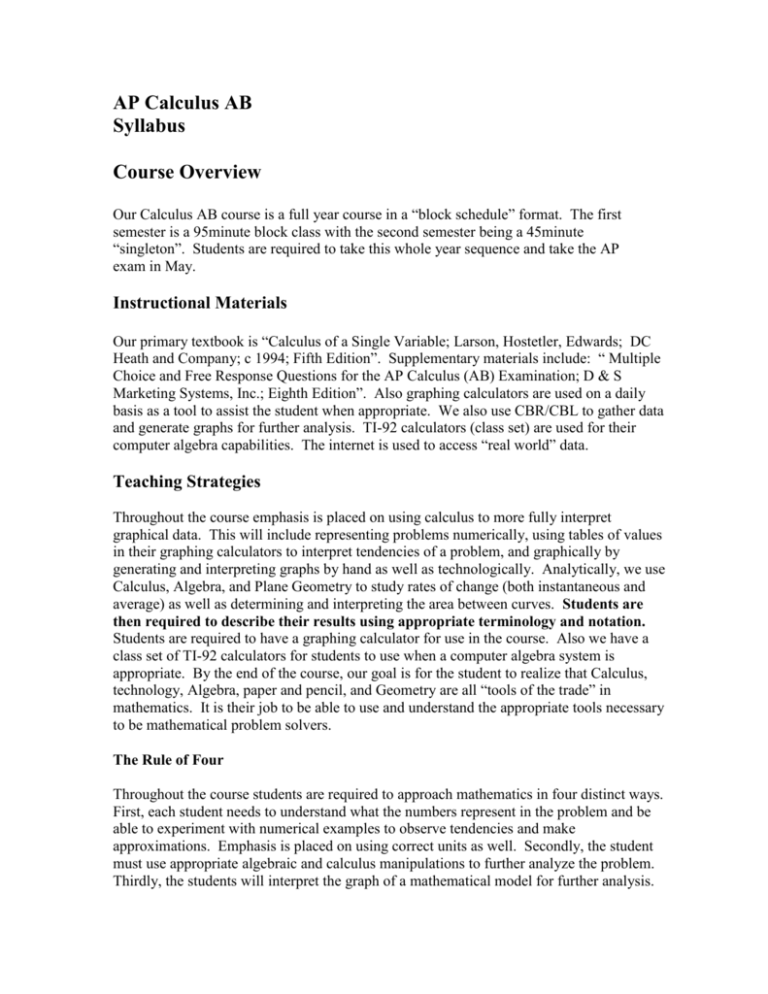
AP Calculus AB Syllabus Course Overview Our Calculus AB course is a full year course in a “block schedule” format. The first semester is a 95minute block class with the second semester being a 45minute “singleton”. Students are required to take this whole year sequence and take the AP exam in May. Instructional Materials Our primary textbook is “Calculus of a Single Variable; Larson, Hostetler, Edwards; DC Heath and Company; c 1994; Fifth Edition”. Supplementary materials include: “ Multiple Choice and Free Response Questions for the AP Calculus (AB) Examination; D & S Marketing Systems, Inc.; Eighth Edition”. Also graphing calculators are used on a daily basis as a tool to assist the student when appropriate. We also use CBR/CBL to gather data and generate graphs for further analysis. TI-92 calculators (class set) are used for their computer algebra capabilities. The internet is used to access “real world” data. Teaching Strategies Throughout the course emphasis is placed on using calculus to more fully interpret graphical data. This will include representing problems numerically, using tables of values in their graphing calculators to interpret tendencies of a problem, and graphically by generating and interpreting graphs by hand as well as technologically. Analytically, we use Calculus, Algebra, and Plane Geometry to study rates of change (both instantaneous and average) as well as determining and interpreting the area between curves. Students are then required to describe their results using appropriate terminology and notation. Students are required to have a graphing calculator for use in the course. Also we have a class set of TI-92 calculators for students to use when a computer algebra system is appropriate. By the end of the course, our goal is for the student to realize that Calculus, technology, Algebra, paper and pencil, and Geometry are all “tools of the trade” in mathematics. It is their job to be able to use and understand the appropriate tools necessary to be mathematical problem solvers. The Rule of Four Throughout the course students are required to approach mathematics in four distinct ways. First, each student needs to understand what the numbers represent in the problem and be able to experiment with numerical examples to observe tendencies and make approximations. Emphasis is placed on using correct units as well. Secondly, the student must use appropriate algebraic and calculus manipulations to further analyze the problem. Thirdly, the students will interpret the graph of a mathematical model for further analysis. Emphasis is placed on the interrelationship between a graph of a function, its derivative, its second derivative, and the area under the curve. And finally, students are required to communicate mathematics both verbally and in written sentences (HIGHLIGHTED THROUGHOUT THE SYLLABUS AND STUDENT ACTIVITIES). Examples include describing how to use the graph of a derivative of a function to determine relative extrema of a function. In a problem involving flow rates (in cubic feet/min) of a local river, groups of students are asked to describe the meaning of the area under the curve and how would you use it to approximate the average rate of flow for a seven-day period. Calculus AB Course Outline Section P.1 P.2 P.3 P.4 P.5 P.6 1.1 1.2 1.3 1.4 1.5 2.1 2.2 2.3 2.4 2.1-2.4 2.5 2.6 2.1-2.6 P.1-2.6 3.1 3.2 3.3 Topics Real numbers, notation, inequalities, absolute value Cartesian plane, distance and midpoint, conic equations Graphs, intercepts, symmetry, models, points of intersection Lines: graphs, slopes, equations parallel and perpendicular Assessment P.1 - P.4 Functions; domain, range, graph, transformations, classify Assessment P.1 - P.5 Angle measure: radian & degree, trigonometric functions trigonometric equations and graphs. Assessment of the Trigonometric topics Timeline Day 1 Day 2 Day 3 Day 4 Day 5 Days 6 - 7 Day 8 Day 9 - 11 Introduction to limits, limits that fail to exist, definition Limit properties, limits of algebraic and trigonometric function Techniques for finding limits, cancellation, rationalization and the Squeeze Theorem. Assessment on early limits Continuity: at a point, on an interval; one sided limits and continuity on a closed interval. The Intermediate Value Thm. Infinite limits and vertical asymptotes Assessment on limits Day 13-14 Day 15 Day 16-17 Derivative of a function, differentiability and continuity. Basic differentiation rules, power, constant, trig… Assessment on derivatives Product & quotient rules, trigonometric deriviatives, higher Chain rule, trig functions with chain rule, simplifying derivitive Comprehensive derivitive review Assessment on derivatives Test. Implicit differentiation Related rates, problem solving with related rates Comprehensive review - implicit diff and related rates Assessment on Chapter 2 Midterm review Midterm exam Extrema and relative extrema of functions, critical numbers Finding extrema on a closed interval. Rolle's Theorem, Mean Value Theorem First derivative test, increasing and decreasing functions Day 23-24 Day 25 Day 26 Day 27-28 Day 29-30 Day 31 Day 32 Day 33-34 Day 35-37 Day 38 Day 39 Day 40-41 Day 42 Day 43-44 Day 12 Day 18 Day 19-20 Day 21 Day 22 Day 45-46 Day 47-48 3.4 3.1-3.4 3.5 3.6 3.7 3.8 3.9 3..10 3.7-3.10 4.1 4.2 4.3 4.4 4.4 4.1-4.4 4.4 4.5 4.6 4.1-4.6 5.1 5.2 5.3 5.4 5.5 Assessment - Extrema, Increasing, Rolle's, M.V.T Concavity, Points of inflection, Second deriviative test Review on Chapter 3 Assessment Chapter 3.1 - 3.4 Limts at infinity, Horizontal asymptotes Summary of all curve sketching techinques - increasing and decreasing, concavity, asymptotes, limits at infinity Assessment Chapter 3.5 - 3.6 Applied problems on Maximums and minimums Assessment on Maximum and minimums Newtons method Day 49 Day 49-50 Day 51 Day 52 Day 53 Day 54 Day 55 Day 56 - 58 Day 59 Day 60 Differentials, Linear approximations, calculating differentials Business and Economic applications Comprehensive review 3.7 - 3.10 Assessment Chapter 3.7 - 3.10 Antiderivatives, notation for, basic integration rules Particular solutions and conditions Sigma notation, areas under curves, upper and lower sums Riemann sums, definite intergrals, properties of definite int Assessment Chapter 4.1 - 4.3 Fundamental Theorem of Calculus I and II. Mean value theorem for intergrals, average value of a function Comprehensive review 4.1 - 4.4 Assessment Chapter 4.1 - 4.4 Review of Fundamental theorem (Back from break) Change of variable technique for integration General power rule, change of variable for definite integrals Assessment Chapter 4.5 Trapezoidal rule, error analysis on approximations Comprehensive review of chapter 4 Assessment Chapter 4 Day 61-62 Day 63-64 Day 65 Day 66 Day 67-68 SEMESTER EXAM Review Chapters P through 4 Semester Exam Day 86-88 Day 90 Review properties of natural logarithmic function and the exponential function Define natural log function as area under the curve f(x)=1/x Differentiate logarithmic functions Use logarithmic differentiation to find derivatives of complicated functions Log rule for integration, Integrals of Trig functions Determine the existence of an inverse function, find the derivative of an inverse function Differentiate and integrate general exponential and logarithmic functions Assessment Chapter 5.1-5.4 Differentiate and integrate exponential functions with bases other than "e". Day 91-92 Day 69-70 Day 71-72 Day 72 Day 73-74 Day 75 Day 76 Day 77 Day 78 Day 79-80 Day 81 Day 82-83 Day 84 Day 85 Day 93 Day 94 Day95 Day 96-97 Day 97-98 Day 99-100 Day 101 Day 102-103-104 5.6 5.7 5.8 6.1 6.2 6.3 7.1 7.3 Apply derivative and integration to exponential growth and decay models Find derivatives of inverse trig functions Evaluate integrals involving inverse trig functions Assessment Chapter 5.1-5.8 Day 105-106 Day 107-108 Day 109 Use definate integral to find area between curves Find the volume of a solid of revolution by both disk and washer method. Find volume of solid with known cross sections. Find the volume of a solid of revolution by the shell method Assessment Chapter 6.1-6.3 Day 110-111 Day 112-116 Use more than one integration rule to evaluate integrals Evaluate trigonometric integrals. Use trig identities to change an integral to a form that can be evaluated directly. Assessment Chapter 7.1,7.3 Day 121-122 day 123-124 Day 116-119 Day 120 Day 125 supplement Generate a slope field when given a differential equation material Find a particular solution to a differential equation's slope field when given a sample point Assessment Slope fields Day 126 Day 127-128 Supplement Review for AP Calculus test Material Weekly assessments on multiple choice, free response practice questions Day 130-154 AP Calculus Exam Day 129 Day 155 6.4 6.5 6.6 6.7 Use integration to compute arc length an surfaces of revolution Compute work done by a variable and constant force Use integration to find fluid force Find center of mass of a planar laminate Assessment Chapter 6.4-6.7 Day 156-157 Day 157-158 Day 159 Day 160 7.2 7.4 7.7 Integration by parts Integration by trigonometric substitution Indeterminant forms and L'Hopital's rule Assessment Chapter 7.2,7.4,7.7 Day 161-162 Day 163-166 Day 167-168 Day 169 Supplement Newton's law of cooling lab Material Use trapezoidal approximation to find total water flow given USGS real time water data of local river flow rates. Day 170-171 Day 172-174 Find position, velocity, acceleration,and total distance traveled of a ball rolling up an inclineplane using CBR and time-distance graph Day 175-177 Assessment Applications of Calculus Day 178-180


